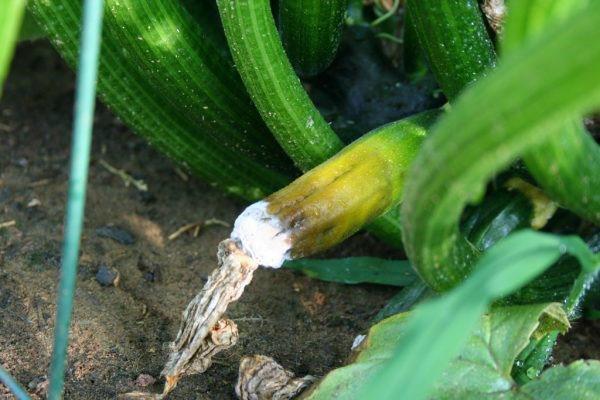How to prevent zucchini ovary decay
 Zucchini form an ovary in late June - early July. Male flowers should fall two weeks before the ovary begins to form. After the male flowers have fallen, the fruit should already begin to thicken. But there are times when the fruit starts to rot instead. This happens for several reasons: from a disease called "Top rot", to poor ventilation of the root system. Let's consider the reasons for ovary decay in more detail.
Zucchini form an ovary in late June - early July. Male flowers should fall two weeks before the ovary begins to form. After the male flowers have fallen, the fruit should already begin to thicken. But there are times when the fruit starts to rot instead. This happens for several reasons: from a disease called "Top rot", to poor ventilation of the root system. Let's consider the reasons for ovary decay in more detail.
Poor pollination of the ovary
Due to rainy weather, bees can poorly pollinate zucchini. Then the female flower does not fall off and over time begins to rot. The rot is transmitted to the ovary, and then the still unformed fruit falls off. To cope with this problem, you need to manually pollinate the female flowers or spray the plant with a sweet solution in order to attract pollinating insects. If the female flower has already rotted, but the rot has not yet spread to the fruit, cut the flower with a sharp knife and remove the competing shoots so that squash redirected nutrients to immature fruits.
Lack of sunlight
If the zucchini bush forms fruits only at the beginning of July, then this means that the plant does not have enough sunlight. For the rapid development of the late ovary, it is necessary to thin out the zucchini. Cut off large leaves covering the sun from the south side.
Trim large leaves off the root, leaving two-thirds of the stem. It will serve as additional food for the ovary.
Also, try not to water the zucchini superficially so that the sun does not burn the ovary. After removing the leaves, the plant should receive moisture only in cloudy weather, otherwise the ovary will not form into a full-fledged fruit.
Vertex rot
A disease called "Top Rot" appears on the leaves of the squash and then spreads to the ovary. The leaves wrinkle first, then dry out and fall off. The same thing happens with the zucchini ovary. The cause of this disease is a lack of potassium in the soil.
To save the zucchini crop, a solution of potassium salt is added to the soil next to the plant for a week.
To increase resistance to this disease, it is necessary to add a weak iodine solution to the soil. This increases the resistance of the squash to viral diseases. Dissolve 30 drops of iodine in 10 liters of water. This solution can be sprayed on zucchini leaves, or added to the soil during one of the waterings.
Good day. Thank you very much for the information. I will definitely cut off the big leaves. This year, due to the rainy weather, we had a lot of rotting ovaries. I didn’t know that large leaves can be cut off.